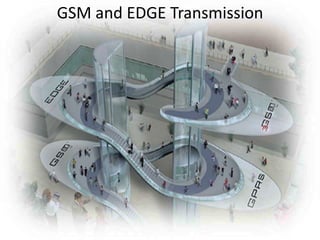
Gsm and edge
- 1. GSM and EDGE Transmission
- 2. What is ? • Global System for Mobile (GSM) is a second generation cellular standard developed to cater voice services and data delivery using digital modulation. • It is a digital, circuit-switched network optimized for full duplex voice telephony. • Most 2G GSM networks operate in the 900 MHz or 1800 MHz bands.
- 4. Channel encoder • Single GSM data block uses 260 random bits • The purpose of the channel encoder is to provide the GSM receiver with the ability to detect transmission errors and eventually correct some of these.
- 5. Input : 260 bits Output : 456 bits Most significant information bits Channel encoding in GSM. A total of 196 redundant bits are added
- 6. Convolution encoder • The convolution encoder takes a block of ‘k’ bits as input and returns a block of ‘n’ bits as output. • The rate of the encoder, defined as the ratio k/n, is in the GSM system specified to be 1/2
- 7. Interleaving • The interleaver shuffles the bits contained in the data blocks output from the channel encoder, and distributes them over a number of bursts. • The purpose of this procedure is to ensure that the errors that appear in a received data block are uncorrelated.
- 9. Multiplexing • Multiplexer takes data from the interleaver, and place it appropriately in a frame structure. • The implemented burst, referred to as a GSM normal burst, has the structure displayed as (Interleaved output bits)/(burst’s) =456/4 = 114 data bits/burst
- 10. GMSK-Modulation • Differential encoding – The sequence of {0,1} is first mapped from the RTZ (Return To Zero) signal representation to a NRZ representation {-1,1}. • GMSK modulation – Gaussian minimum-shift keying – We get {I,Q} components as output
- 11. Advantages of GSM over Analog system • Reduced RF transmission power and longer battery life. • International roaming capability. Encryption capability for information security and privacy. Applications of GSM • Mobile telephony • SMS (Short messaging service) • Value added services
- 12. Evolution of GSM • 2nd Generation GSM -9.6 Kbps (data rate) • 2.5 Generation GPRS (General Packet Radio service) Data rate: 14.4 - 115.2 Kbps EDGE (Enhanced data rate for GSM Evolution) Data rate: 547.2 Kbps (max) • 3rd Generation WCDMA(Wide band CDMA) Data rate : 0.348 – 2.0 Mbps
- 13. EDGE • Enhanced Data rates for GSM Evolution (EDGE) is a digital mobile phone technology that allows improved data transmission rates as a backwardcompatible extension of GSM. • Threefold increase in capacity and performance compared with an ordinary GSM/GPRS connection • EDGE increased the bandwidth of GSM from 144 Kbps to 384 Kbps.
- 14. Implementation of EDGE • No hardware or software changes to be made in GSM core networks, only base stations must be modified. • EDGE compatible transceiver units must be installed in Base Station Subsystem hardware. • Software upgrades to the Base Station Controller (BSCs) and Base Stations (BS). EDGE is just an “add-on” to the BSS. • A new modulation scheme “8-PSK” is introduced to provide high data rate and high spectral efficiency.
- 15. EDGE Modulation • EDGE produces a 3-bit word for every change in carrier phase. This effectively triples the gross data rate offered by GSM.
- 16. EDGE Channel Coding and Frame Structure Burst N 464 bits 1 data block Convolution Coding Rate = 1/3 Length = 7 Puncture 1392 bits Interleave Burst N+1 1392 bits Burst N+2 8PSK Modulate 156.25 symbols/slot Burst Format 468.75 bits Burst N+3 348 bits 20 msec frame with 4 time-slots for each of 8 bearers 8 Time Slots 0 1 2 3 4 5 6 7 1 Time Slot = 576.92 µs Tail symbols 3 Data symbols 58 Training symbols 26 Data symbols 58 Modulation: 8PSK, 3 bits/symbol Symbol rate: 270.833 ksps Payload/burst: 348 bits Gross bit rate/time slot: 69.6 kbps - overhead = 59.2 kbps user data Tail symbols 3 Guard symbols 8.25 348 bits/ burst
- 17. Advantages of EDGE User Benefits 1. Speed 2. An “always-on” connection 3. Coverage Operator Benefits 1. Spectrally efficient and flexible 2. Ease of upgrade 3. Backward compatibility 4. Cost-efficiency
- 18. Applications of EDGE • EDGE enables operators to introduce 3G data applications into existing GSM networks and thereby increase the speed of packet oriented transmission three-fold. – Mobile Internet access – Wireless access to databases – e-Commerce – Video telephony – MMS
- 19. Matlab implementation 1. 2. 3. 4. 5. 6. 7. 8. 9. Generate random data of length 260 Separate input in classes 1a,1b,2 Parity encoding of most important 50 bits (1a) Convolution encoding Interleaving Multiplexing Differential encoding GMSK modulation Transmit {I,Q} components
